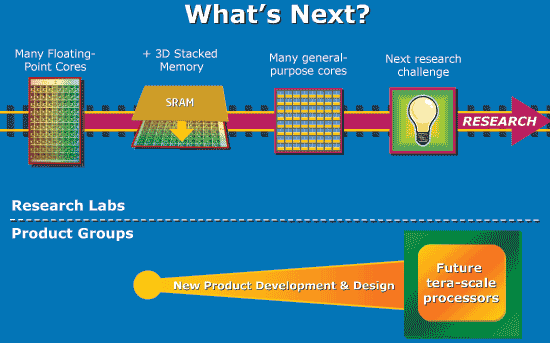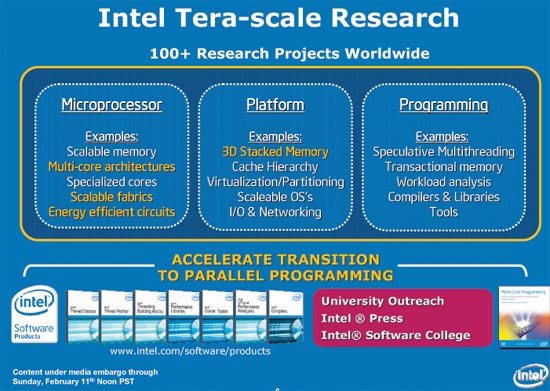The Era of Tera: Intel Reveals more about 80-core CPU
by Anand Lal Shimpi on February 11, 2007 5:44 PM EST- Posted in
- CPUs
Final Words
As Cell-like as Intel's Teraflop Research Chip may be, it's never going to be a product. In fact, there's no rhyme or reason to choosing 80 cores as the magic number, it was simply the number of cores Intel was able to cram into the design given the target die size. At the same time, the teraflop chip isn't here to set any performance records either, its sole purpose is as a test vehicle for its tiled network approach, power management with many cores, 3D stacked memory, and as a whole for the future of multi-core processors.

Intel stated that the two next steps for this research chip are to introduce a 3D stacked die, which we're suspecting Intel has already made significant progress on, and to introduce some more capable cores.
Intel's goal with this chip isn't to build a FP monster, but rather a fast general purpose chip. Chances are that what this chip evolves into won't be an array of 80 general purpose processors, but maybe an 8 or 16 core chip complete with x86 cores, specialized hardware, and 3D stacked memory.

What's the time to fruition for these technologies? Intel estimates 5 - 10 years before we see the tangible benefits of this research in products. By the end of the decade we can expect quad-core to be mainstream on the desktop, so by 2015 you can expect that many of these many-core problems we recapped here today will be a reality. Intel's Tera-scale research that we've seen today will hopefully mitigate those problems, leading to a much smoother transition to the era of tera.










25 Comments
View All Comments
Navitron - Monday, February 12, 2007 - link
In the words of bill gates "No one will need more than 637 kb of memory for a personal computer." You sound just like him :P Don't bash the technology just because "right now" we don't need it. But what about in 10-20 years, you still think your core 2 duo is gonna cut it in 15 years? Can a IBM 80386 run doom 3? will todays AMD and Intels run -insert game here- 10 years from now.So don't assume just because we don't need it now doesn't mean we wont need it in 3 years.
cscpianoman - Sunday, February 11, 2007 - link
The average consumer might not need it, but large industries will be grabbing at these things faster than you can imagine. Think of health care, for example, the trend is to move towards genetic manipulations/prescreening. These industries want to download a person's entire genetic information, process it, and return it to you with the results of Alzhiemer's, cancer, and heart problems in a matter of minutes. Furthermore, the entertainment industry would love to create more special effects and render them that much faster. I'm sure if they could Pixar would already be placing an order for these. There are hundreds of applications out there that require the power and capability of multi-cores. Sure the consumer may not need it, but the consumer only accounts for less than approx. 5% of what Intel, AMD or whoever makes.mino - Sunday, February 11, 2007 - link
They need it (to sell). Period.Justin Case - Sunday, February 11, 2007 - link
In other words, Intel is doing the same that IBM and AMD (with Cell and Torrenza + Fusion), only with some made-up numbers and more Powerpoint charts. Unless they vastly improve their compilers' paralellization, or come up with a full suite of software optimized for multi-core chips (80? It's hard enough to take full advantage of 4!), this will remain something that "can be done", but which most people will have no use for.joex444 - Sunday, February 11, 2007 - link
attack switch